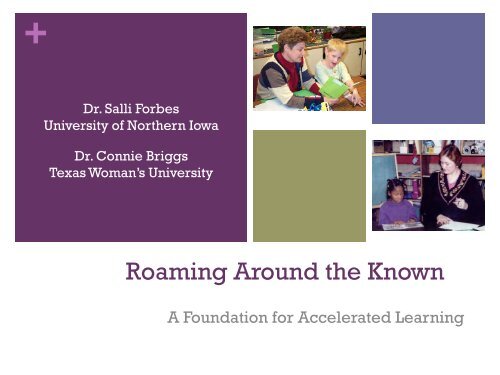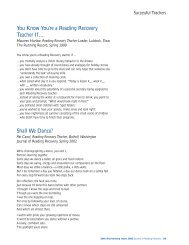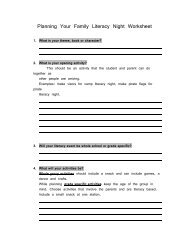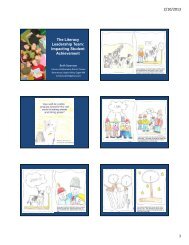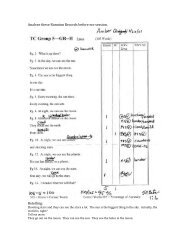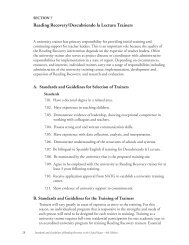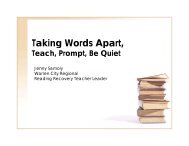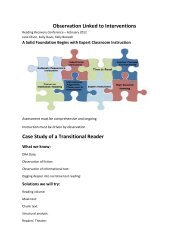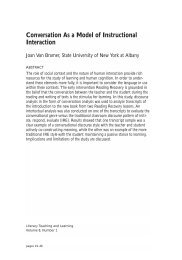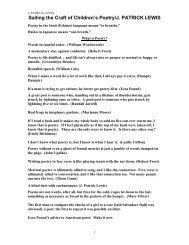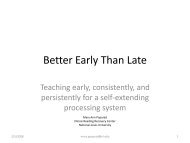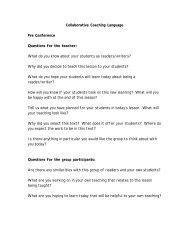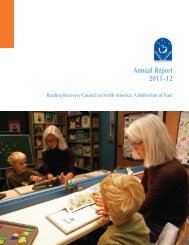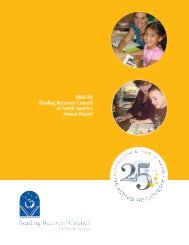Roaming Around the Known - Reading Recovery Council of North ...
Roaming Around the Known - Reading Recovery Council of North ...
Roaming Around the Known - Reading Recovery Council of North ...
You also want an ePaper? Increase the reach of your titles
YUMPU automatically turns print PDFs into web optimized ePapers that Google loves.
+<br />
Dr. Salli Forbes<br />
University <strong>of</strong> Nor<strong>the</strong>rn Iowa<br />
Dr. Connie Briggs<br />
Texas Woman’s University<br />
<strong>Roaming</strong> <strong>Around</strong> <strong>the</strong> <strong>Known</strong><br />
A Foundation for Accelerated Learning
+<br />
Objectives <strong>of</strong> this session<br />
•Participants will understand <strong>the</strong><br />
key concepts <strong>of</strong> <strong>Roaming</strong> <strong>Around</strong><br />
<strong>the</strong> <strong>Known</strong>.<br />
•Participants will understand how<br />
<strong>the</strong>se key concepts provide <strong>the</strong><br />
opportunity for accelerated<br />
learning.
Key Concepts <strong>of</strong><br />
<strong>Roaming</strong> <strong>Around</strong> <strong>the</strong> <strong>Known</strong><br />
•Work within <strong>the</strong> child’s<br />
known<br />
•Observe sensitively<br />
+<br />
•Work with continuous text<br />
•Co-construct literacy<br />
tasks<br />
•Actively engage <strong>the</strong> child<br />
in reading and writing<br />
•Converse with <strong>the</strong> child
+ Preparing to work within a child’s<br />
known<br />
•Observation Survey and Summary<br />
•Finding Readable Texts<br />
•Record <strong>of</strong> Oral Language<br />
•Prediction <strong>of</strong> Progress<br />
•Create a data card <strong>of</strong> <strong>the</strong> child’s known<br />
•Personal Information<br />
•Data Card
Work within <strong>the</strong> child’s known<br />
+<br />
“Stay with what <strong>the</strong><br />
child already knows<br />
how to do.”<br />
LLDI Part 1, p. 32
Work within <strong>the</strong> child’s known<br />
+<br />
“…<strong>the</strong> brain always<br />
reacts to <strong>the</strong><br />
environment.”<br />
Zull, 2011, p. 63
Work with <strong>the</strong> child’s known<br />
+<br />
“Do not deliberately<br />
teach him any new<br />
items or processes.”<br />
LLDI Part 1, p. 32
Work with <strong>the</strong> child’s known<br />
+<br />
“Build fluency on <strong>the</strong><br />
very little he knows.”<br />
LLDI Part 1, p. 34
Work with <strong>the</strong> child’s known<br />
+<br />
“At <strong>the</strong> end <strong>of</strong> <strong>the</strong> period<br />
<strong>the</strong> child will feel<br />
comfortable with a small<br />
body <strong>of</strong> knowledge and<br />
confident to use this as a<br />
springboard for trying new<br />
things when <strong>the</strong> instruction<br />
starts. This is a firm<br />
foundation on which to<br />
build.”<br />
LLDI Part 1, pp. 32-33
Observe sensitively<br />
+<br />
The Observation<br />
Survey is a starting<br />
point, but it does not<br />
provide enough<br />
information.
Observe sensitively<br />
+<br />
“New behaviours<br />
may appear.”<br />
LLDI Part 1, p. 36
Observe sensitively<br />
+<br />
“The teacher is free to<br />
observe <strong>the</strong> child<br />
without <strong>the</strong> need to<br />
record all that occurs<br />
or to think particularly<br />
<strong>of</strong> her next teaching<br />
moves, although<br />
making notes is<br />
necessary.”<br />
LLDI Part 1, p. 36
Work with continuous text<br />
(in reading and writing)<br />
+<br />
“Encourage his<br />
participation in<br />
reading.”<br />
LLDI Part 1, p. 35<br />
“Encourage his<br />
participation in<br />
writing.”<br />
LLDI Part 1, p. 36
Work with continuous text<br />
(in reading and writing)<br />
+<br />
“This seems to give<br />
<strong>the</strong> child <strong>the</strong> feeling<br />
that he is ‘really<br />
reading and writing.”<br />
LLDI Part 1, p. 32
Work with continuous text<br />
(in reading and writing)<br />
+<br />
“This purposeful<br />
kind <strong>of</strong> integration is<br />
also used to create<br />
language. It must<br />
occur when we write<br />
or speak.”<br />
Zull, 2011, p. 92
Co-construct Tasks<br />
(task-sharing)<br />
+<br />
“There should be a<br />
balance between<br />
receiving knowledge<br />
and using<br />
knowledge.”<br />
Zull, 2002, p. 45
Co-construct Tasks<br />
(task-sharing)<br />
+<br />
“Aim to have <strong>the</strong><br />
child in control <strong>of</strong><br />
some key activities.”<br />
LLDI Part 1, p. 35
Actively engage <strong>the</strong> child in<br />
reading and writing<br />
+<br />
“Being sensitive to<br />
<strong>the</strong> learner’s thinking<br />
allows <strong>the</strong> teacher to<br />
draw <strong>the</strong> child’s<br />
attention to many<br />
things.”<br />
LLDI Part 1, p. 34
Actively engage <strong>the</strong> child in<br />
reading and writing<br />
+<br />
“Learning takes<br />
place through action,<br />
but it is driven by<br />
emotion.”<br />
Zull, 2011, p. 54
Actively engage <strong>the</strong> child in<br />
reading and writing<br />
+<br />
“So we might say that<br />
our best chance to<br />
help ano<strong>the</strong>r person<br />
learn is to find out<br />
what <strong>the</strong>y want, what<br />
<strong>the</strong>y care about.”<br />
Zull, 2002, p. 48
Actively engage <strong>the</strong> child in<br />
reading and writing<br />
+<br />
“We take actions<br />
because <strong>the</strong>y are<br />
associated with<br />
intrinsic reward, and<br />
this behavior<br />
produces learning.”<br />
Zull, 2002, p. 70
Actively engage <strong>the</strong> child in<br />
reading and writing<br />
+<br />
“Doing things we<br />
have learned<br />
produces results that<br />
please us.”<br />
Zull, 2002, p. 70
Actively engage <strong>the</strong> child in<br />
reading and writing<br />
+<br />
“If we focus on <strong>the</strong><br />
work itself ra<strong>the</strong>r<br />
than <strong>the</strong> extrinsic<br />
reward, <strong>the</strong> intrinsic<br />
reward systems can<br />
begin to engage.”<br />
Zull, 2002, p. 60
Actively engage <strong>the</strong> child in<br />
reading and writing<br />
+<br />
“…active learning<br />
that involves choice<br />
and actions by <strong>the</strong><br />
learner is<br />
pleasurable and<br />
effective...”<br />
Zull, 2002, p. 63
Converse with <strong>the</strong> child<br />
+<br />
“The teacher in<br />
conversation with <strong>the</strong><br />
child creates<br />
opportunities for <strong>the</strong><br />
child to talk, and to<br />
talk more.”<br />
LLDI Part 1, p. 34
+ “…<strong>the</strong> most important reason for<br />
‘<strong>Roaming</strong> around <strong>the</strong> known’ is that<br />
it requires <strong>the</strong> teacher to stop<br />
teaching from her preconceived<br />
ideas. She has to work in was that<br />
will suit each child, working with<br />
what he is able to do. This will be<br />
her focus throughout <strong>the</strong> lesson<br />
series.”<br />
LLDI Part 1, p. 33
+ Intended Daily Goals <strong>of</strong><br />
<strong>Roaming</strong> <strong>Around</strong> <strong>the</strong> <strong>Known</strong><br />
Building <strong>the</strong> child’s ownership <strong>of</strong><br />
learning through:<br />
• Confidence<br />
• Ease<br />
• Flexibility<br />
• Discovery
+ <strong>Recovery</strong> <strong>the</strong> child’s<br />
engagement and active learning<br />
“ . . . The struggling reader and writer<br />
has stopped trying to problem-solve<br />
because he could not be successful. If<br />
you give him your support and he<br />
succeeds <strong>the</strong>n he begins to try again<br />
to use some <strong>of</strong> <strong>the</strong> old discarded<br />
strategic activities. Once he is doing<br />
this he can discover new things that<br />
work. You should show delight when<br />
he relates this to that.”<br />
p. 36<br />
Clay, 2005, Literacy Lessons Designed for Individuals, Part One,
+<br />
References<br />
Anderson, N. (1999). Language patterns that may help or hinder.<br />
Network News. Columbus, OH: <strong>Reading</strong> <strong>Recovery</strong> <strong>Council</strong> <strong>of</strong><br />
<strong>North</strong> America.<br />
Clay, M.M. (1991). Becoming literate: The construction <strong>of</strong> inner control.<br />
Portsmouth, NH: Heinemann.<br />
Clay, M. M. (2005). Literacy lessons designed for individuals, Part one<br />
why where and how Portsmouth, NH: Heinemann.<br />
Clay, M. M. (2005). Literacy lessons designed for individuals, Part two<br />
why where and how Portsmouth, NH: Heinemann.<br />
Zull, J. (2002). The art <strong>of</strong> <strong>the</strong> changing brain: Enriching <strong>the</strong> practice <strong>of</strong><br />
teaching by exploring <strong>the</strong> biology <strong>of</strong> learning. Sterling, VA: Stylus<br />
Publishing.<br />
Zull, J. (2011). From brain to mind: Using neuroscience to guide change<br />
in education. Sterling, VA: Stylus Publications.


